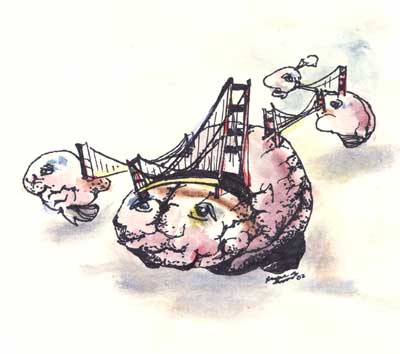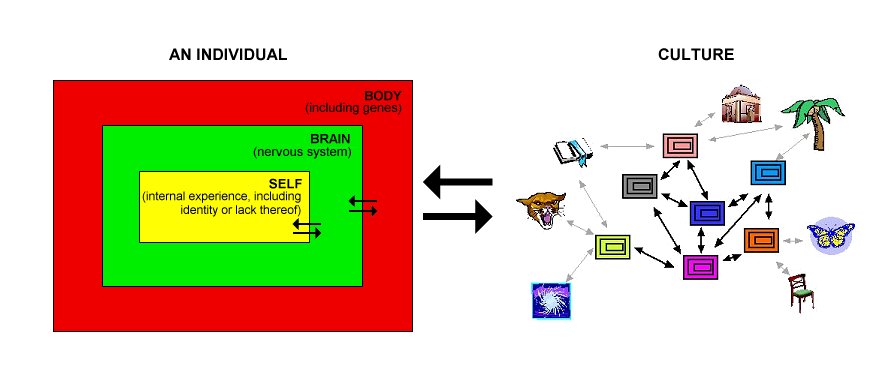Serendip is an independent site partnering with faculty at multiple colleges and universities around the world. Happy exploring!
The Brain and Social Organization / Culture
The Brain and Social Organization / Culture

Inquiring into the nature of human social interactions and culture has until recently largely been the business of the social sciences and humanities, while inquiries into the brain have been primarily the province of biology and psychology. These borders are beginning to break down as it becomes ever clearer that the organization and function of the brain both reflects and contributes to social organization and culture. Elsewhere on Serendip is a section focused on the reciprocal relationship between individual and cultures. Here we will be bringing together materials that are relevant to thinking about the brain as the nodal point of these reciprocal relationships, a material entity whose interactions both produce social interactions and culture and which is in turn shaped in part by such interactions and their products.
Additions to this material, as well as your thoughts about it are welcome in the on-line forum area below.
Originally posted May 2008 by Ian Morton and Paul Grobstein.
An Overview 
An individual, as illustrated to the left, consists of a body within
which is embedded a nervous system. Embedded within that, in turn,
is a subset of the nervous system (the "mind") that supports all internal experiences, all
that is associated with being aware, including one's experiences and understandings of one's
surroundings, of one's self, and of the relation between them. Information
about what is outside the individual reaches the mind only via
successive interactions between that and the body, between the body and
the nervous system, and between the portion of the nervous system
outside the mind and that inside it. Similarly, the mind can influence
what is outside the individual only by successive interactions with the rest of the nervous system and the body. The upshot is that all of one's conscious experiences and understandings are "stories", influenced by unconscious processes and subject to continuing revision. And one's interactions with the "world" always reflect both one's stories and influences both of the unconscious ("tacit" information) and of the body outside the nervous system. Hence the "self" one is aware of may well be different from the individual as seen by other individuals.An individual is thus a complex entity in which are blended genetic and environmental influences together with internal constructions that use but go beyond those influences.
The "world," as illustrated to the right, includes other similarly complex human individuals together with inanimate creations of humans and other animate and inanimate entities. Culture is the resultant of bidirectional interactions among all of these enitites. Human social organization and culture are the resultants of all of these interactions expressed as more or less predictable properties of group of humans and/or the artifacts they create and stories they tell in common. Social organization and culture are therefore both influences on and influenced by individuals, as illustrated by the large bidirectional arrows in the center of the figure. It further follows that social organization and cultures will reflect aspects of the organization of individuals but will also display "emergent" properties not simply related to those of individuals. Hence iinquiries into the brain can be expected to contribute to understanding social organization and culture but should not be expected to replace iinquiries of the sort that have in the past characterized the social sciences and the humanities. One should expect instead that the two sorts of studies can and will mutually reinforce one another.
Serendip resources
- The Brain, Story Sharing, and Social Organization. Paul Grobstein, September 2007.
- The Brain as a Learner/Inquirer/Creator: Some Implications of its Organization for Individual and Social Well Being. November 2007.
- Social Neuroscience: Current Understandings of the Social Condition and Future Directions. Ian Morton, January 2008.
- Social Cognition and the Bipartite Brain. Ian Morton, May 2008
- Brain and Culture: The Crossroads Between Humanity and Biology. Angel Desai, May 2008
- Commentaries on Nisbett's Geography of Thought: How Asians and Westerners Think Differently ... and Why (see below)
-
Confucious Versus Aristotle, jrieders, April 2008
- The Geography of Thought: Asian and Western Minds at Work. jwong, May 2008
- East Versus West: A Commentary, Mahvish Quereshi, May 2008
- The Geography of Thought: A Commetary, Rica Dela Cruz, May 2008
- Cultural Cognition Theory, jrieders, May 2008
-
Other resources
Neuroanthropology, a collaborative weblog
Nisbett, Richard E. Geography of Thought: How Asians and Westerners Think Differently ... and Why. NY: Simon and Shuster, 2003
Wexler, Bruce. Brain and Culture: Neurobiology, Ideology, and Social Change. Cambridge: MIT Press.2006



Comments
Post new comment